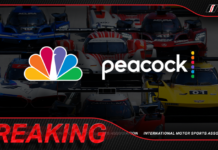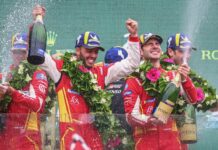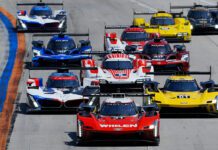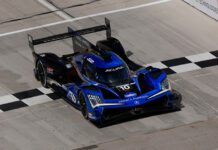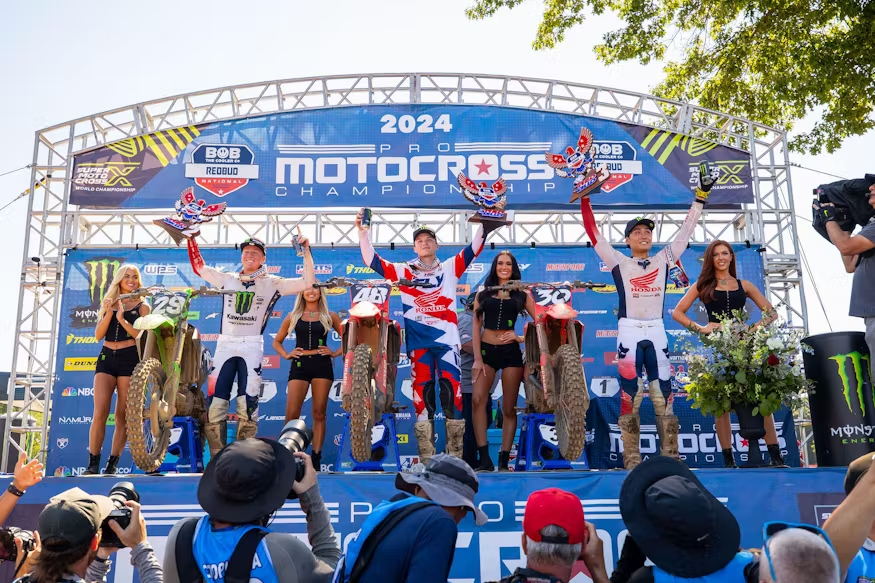NASCAR champion Kevin Harvick’s son, Keelan, is a rising go-kart star who dreams of reaching the major leagues to race his favorite star – reigning F1 champion Max Verstappen.
With Formula One recently announcing the addition of a third U.S. race next year, the global series’ spike in domestic popularity could mean more head-to-head competition with NASCAR, IndyCar and IMSA for race fans.
But Kevin Harvick (pictured above with Keelan) is much more worried about the F1 surge’s long-term ramifications on the pipeline of young American talent to the country’s major racing series.
“I live at the go-kart track and none of those kids want to race Indy cars; they all want to race F1 cars,” Harvick said Saturday at Richmond Raceway. “They all want to drive the Ferrari or the Red Bull. This is something that I’ve talked with (NASCAR chairman and CEO) Jim France and with people in our garage is how do we make sure that all those kids whose dreams don’t come true, how do we create them to be gentlemen racers and put them in sports car racing and attract the great ones over to NASCAR.
“A lot of those kids from the go-kart side of the world, there’s a lot of really good talented kids there and they wind up going down that open-wheel path and wind up in Europe. You have a lot of the people that can’t make it that far and we lose a lot of those gentlemen races that would really make our sports car stuff more solid because there’s a lot of people that spend a lot of money that get disenchanted with racing.
“In go-karts, the dream is not to race (in NASCAR), it’s not to race in IndyCar.”
Harvick said he has tried to steer rising prospects Brent Crews and Connor Zilisch (who both are under management with Kevin Harvick Inc.) away from potential European opportunities and toward stock cars.
Harvick is trying to do the same with Keelan, who races in various national karting series (often under the tutelage of his father, the 2014 Cup Series champion and 58-time winner in NASCAR’s premier series).
But his son, who turns 10 in July, is an avid F1 viewer who watches every race and chatters constantly with his peers about racing in Europe and rising through the ranks in the footsteps of Verstappen and Ferrari’s Charles Leclerc — even though “there are thousands of them across the world and there’s only 20 cars (in F1),” Kevin Harvick said. “The dream of it actually happening is slim to none.
“It’s just that everything that they do it tells them that that’s where they need to be. That’s what they see, There’s really nobody that tells them that their dream will most likely never will be reality, it’s, ‘OK and come over and race our F3 car.’ ”
Harvick, though, is realistic about the chances of Keelan Harvick finding his way to an F1 driver academy like Verstappen and Leclerc.
“He’s got no chance of going F1 racing,” Kevin Harvick said. “We try to make him think he’s got a chance to go F1 racing so he will try to overachieve in go-kart racing. It’s reverse psychology up until the point he realizes.”

The Harvicks might be attending an F1 race for the first time in the near future, and they’ll have many options. The inaugural Miami Grand Prix will be held next month, joining the Circuit of the Americas race in Austin, Texas, that has been on the F1 schedule since 2012.
Las Vegas and F1 announced last Wednesday that Sin City will become a third U.S. stop next year.
The new races directly are correlated to the success of the “Drive to Survive” show that recently launched its fourth season on Netflix (Harvick said he’s watched every episode). But it also has prompted questions about whether F1 is oversaturating the American market (which had no races from 1992-99 and 2008-11).
Chase Elliott is an avowed fan of F1 and “Drive to Survive” who spent a 2017 NASCAR off weekend attending the Spa race in Belgium with Ryan Blaney.
The 2020 series champion won’t be attending the Las Vegas race (which likely will happen after the NASCAR season concludes) but is planning to watch on TV with curiosity about whether F1 continues to grow after selling out Austin in consecutive years.
“I’m a big believer in less is more,” Elliott said. “I think that’s one of the reasons why (F1 is) successful. It’s a whole different ballgame worldwide. Coming to a certain area one time a year, I think it gets people really excited for that because they can’t see it again until the next calendar year. So I’m curious to see how that works out for them (with three U.S. races).
“I’m super intrigued by it. Respect all those drivers and teams a lot. I think they’re really good at what they do. I’ve enjoyed being a fan. I think you have to respect each discipline because it takes a different approach to be successful in each of them. I think a guy who is at the top of his game in each category of motorsports is very good at whatever he does, but it’s just a different approach than what I think we do here.
“It’s still very entertaining. I think they have a good product. Obviously, they’ve gained a lot of traction here in the States over the last few years, which is cool. Maybe over time the folks that have grown to respect that type of motorsport racing will navigate our way and respect what we do because there’s a lot of really talented teams and drivers here, too, that deserve recognition as well.”
Blaney, who is considering attending the Vegas race next year, doesn’t view F1 as a threat to NASCAR but as a professional example for worldwide racing expansion.
“I love F1,” the Team Penske driver said after qualifying on the pole position at Richmond. “I think if you ask anybody in motorsports, you’re just fans of other forms of motorsport. You’re fascinated by what’s different and what’s the same. How they operate compared to us.
“I got the chance to go to an F1 race in Spa a few years ago and it was really, really cool just to see their world. There are a lot of similarities of how it operates, but a lot of different things, so I think it’s great. It’s cool that they’re coming to two brand new tracks in the U.S. from Miami and then Vegas, so I think it’s great and it’s definitely not a competition. It’s not going to hurt our sport any. I think it helps motorsports all around,”
While he sees no competition for NASCAR, Harvick wonders about what it could mean for IndyCar, which bears more in common with F1 being a traditionally single-seater, open-cockpit series.
In an Autoweek story last week, 2016 Indy 500 winner Alexander Rossi said F1’s U.S. expansion was “something that (IndyCar) need to be aware of and concerned about to a certain degree.”
Harvick said he tried to broach the subject with IndyCar officials.
“IndyCar in general I think there’s a huge competition there as far as those guys go,” Harvick said. “I raised the same awareness to them, and they just blew me off. Never even had a conversation about it.”
Though the NTT IndyCar Series schedule has yet to be confirmed for next year, the 2022 schedule will end Sept. 11 at Laguna Seca, making it unlikely it’ll conflict with the F1 races in Austin (which usually is held in the fall) and Las Vegas (scheduled for November 2023).











